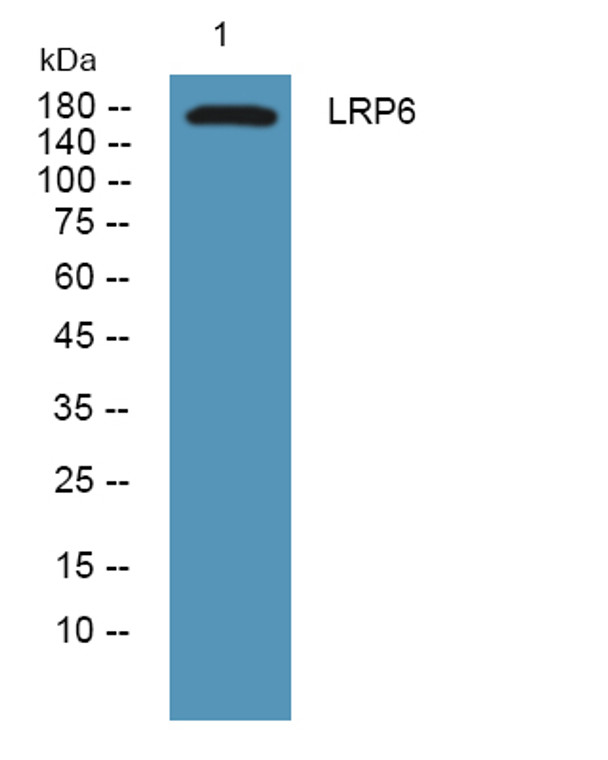| Host: |
Rabbit |
| Applications: |
WB/ELISA |
| Reactivity: |
Human/Mouse |
| Note: |
STRICTLY FOR FURTHER SCIENTIFIC RESEARCH USE ONLY (RUO). MUST NOT TO BE USED IN DIAGNOSTIC OR THERAPEUTIC APPLICATIONS. |
| Short Description: |
Rabbit polyclonal antibody anti-Low-density lipoprotein receptor-related protein 6 (1420-1500 aa) is suitable for use in Western Blot and ELISA research applications. |
| Clonality: |
Polyclonal |
| Conjugation: |
Unconjugated |
| Isotype: |
IgG |
| Formulation: |
Liquid in PBS containing 50% Glycerol and 0.02% Sodium Azide. |
| Purification: |
The antibody was affinity-purified from rabbit antiserum by affinity-chromatography using epitope-specific immunogen. |
| Concentration: |
1 mg/mL |
| Dilution Range: |
WB 1:500-2000ELISA 1:5000-20000 |
| Storage Instruction: |
Store at-20°C for up to 1 year from the date of receipt, and avoid repeat freeze-thaw cycles. |
| Gene Symbol: |
LRP6 |
| Gene ID: |
4040 |
| Uniprot ID: |
LRP6_HUMAN |
| Immunogen Region: |
1420-1500 aa |
| Specificity: |
LRP6 Polyclonal Antibody detects endogenous levels of protein. |
| Immunogen: |
Synthesized peptide derived from the human protein at the amino acid range 1420-1500 |
| Post Translational Modifications | Dual phosphorylation of cytoplasmic PPPSP motifs sequentially by GSK3 and CK1 is required for AXIN1-binding, and subsequent stabilization and activation of beta-catenin via preventing GSK3-mediated phosphorylation of beta-catenin. Phosphorylated, in vitro, by GRK5/6 within and outside the PPPSP motifs. Phosphorylation at Ser-1490 by CDK14 during G2/M phase leads to regulation of the Wnt signaling pathway during the cell cycle. Phosphorylation by GSK3B is induced by RPSO1 binding and inhibited by DKK1. Phosphorylated, in vitro, by casein kinase I on Thr-1479. Undergoes gamma-secretase-dependent regulated intramembrane proteolysis (RIP). The extracellular domain is first released by shedding, and then, through the action of gamma-secretase, the intracellular domain (ICD) is released into the cytoplasm where it is free to bind to GSK3B and to activate canonical Wnt signaling. Palmitoylation on the two sites near the transmembrane domain leads to release of LRP6 from the endoplasmic reticulum. Mono-ubiquitinated which retains LRP6 in the endoplasmic reticulum. Ubiquitinated by ZNRF3, leading to its degradation by the proteasome. N-glycosylation is required for cell surface location. |
| Function | Component of the Wnt-Fzd-LRP5-LRP6 complex that triggers beta-catenin signaling through inducing aggregation of receptor-ligand complexes into ribosome-sized signalosomes. Cell-surface coreceptor of Wnt/beta-catenin signaling, which plays a pivotal role in bone formation. The Wnt-induced Fzd/LRP6 coreceptor complex recruits DVL1 polymers to the plasma membrane which, in turn, recruits the AXIN1/GSK3B-complex to the cell surface promoting the formation of signalosomes and inhibiting AXIN1/GSK3-mediated phosphorylation and destruction of beta-catenin. Required for posterior patterning of the epiblast during gastrulation. |
| Protein Name | Low-Density Lipoprotein Receptor-Related Protein 6Lrp-6 |
| Database Links | Reactome: R-HSA-201681Reactome: R-HSA-3772470Reactome: R-HSA-4641262Reactome: R-HSA-4641263Reactome: R-HSA-5340588 |
| Cellular Localisation | Cell MembraneSingle-Pass Type I Membrane ProteinEndoplasmic ReticulumMembrane RaftOn Wnt SignalingUndergoes A Cycle Of Caveolin- Or Clathrin-Mediated Endocytosis And Plasma Membrane LocationReleased From The Endoplasmic Reticulum On PalmitoylationMono-Ubiquitination Retains It In The Endoplasmic Reticulum In The Absence Of PalmitoylationPhosphorylatedAggregates And Colocalizes With Axin1 And Gsk3b At The Plasma Membrane In Lrp6-SignalosomesChaperoned To The Plasma Membrane By Mesd |
| Alternative Antibody Names | Anti-Low-Density Lipoprotein Receptor-Related Protein 6 antibodyAnti-Lrp-6 antibodyAnti-LRP6 antibody |
Information sourced from Uniprot.org
12 months for antibodies. 6 months for ELISA Kits. Please see website T&Cs for further guidance







